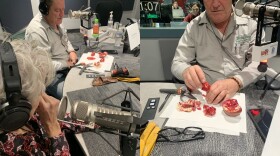
The sun’s shining more and the weather … well, is starting to get warmer despite an incoming cold snap. It's the perfect time to start planning your garden and getting your green thumb ready.
We all know that Nevadans love gardening, and it's even more important now with the rising prices of groceries due to inflation. But with the changing climate, timing is everything. Heat comes earlier and lasts longer, so when should you start planting?
And how can you care for your trees and plants? It can be a little overwhelming.
But don't worry, we've got you covered. We have two experts in the field, Norm Schilling and Angela O'Callaghan, co-hosts of Nevada Public Radio's Desert Bloom, who know more about gardening than most of us could ever dream of.

What should you prepare to plant?
O’CALLAGHAN: First, you want to take a look and see what you have growing there. One of the things that we don't really talk too much about is some of the earliest plants that we see in the beginning of the end of winter, beginning of spring. Some of the earliest things are weeds. So some of the grassy plants, the brooms that just pop up and they appear out of nowhere, but they really are not something you want to maintain. Also a lot of the mustards, things that are really, actually related to things like broccoli and cabbage, but these are, well, they're weeds. I mean, you can pull them up and eat them. But they are nonetheless weeds.
SCHILLING: Since we delved into weeds, here's the thing, don't ever spend a day weeding, it'll kill your love of gardening. On rainy days, the next day go out and weed. Water acts as a lubricant in the soil. When I weed, I will set myself a 10 minute goal, I will go out and weed for 10 minutes and make some progress. And then you know, I'll give myself five bonus minutes and feel really good about it. Don't try and take it all on. And here's the real key. You'll get to recognize weeds, right? You want to get them out before they go to seed. … Get it out of there. And finally, use a trowel especially in in moist soil and dig down a little bit under the base, loosen it up, and then that plant will just pop right out.
What tools or techniques should you consider?
SCHILLING: My personal favorite gardening tool is called a Leshe digging tool. … I've had mine for 30 years. I wear it every day when I go out on consultations. It's forged steel, it's going to cost you 50 bucks, comes with a cool little holster, you wear it on your belt, take it out in the garden, you can pry rocks out of the ground, you will never break it. It's a one time lifetime investment. Before I had that, I broke, I don't know, like six, eight, 10 trowels, trying to just dig and move little rocks. It's a wonderful long term investment.
When cleaning old plants or debris, should it be composted?
O’CALLAGHAN: Usually composting is the best bet. But remember, if it's a woody plant, you're gonna have to really chop it up very fine, because it's going to take a long time to break down. But certainly, unless it's been infected with a disease, if you saw a lot of aphids or squash bugs, then don't put it in your compost because you're just asking for trouble. So if it's been a problem that died of disease, or died because the infestation of aphids simply overwhelmed it, or they transmitted all manner of other diseases, you have to take that out, you bag it up, and that you do send to the dump.
What can you plant right now?
O’CALLAGHAN: Usually what we say is during the spring when the weather is still cool, what you should be looking at is growing things for their leaves. Things for roots, things for bulbs, so you can be planting onions now. You'll get them at the end of summer. But also things like any of the leaves, so spinach, the broccoli greens, cabbages.
What are colorful desert options?
SCHILLING: Go for spurge. So when I think of color, I'm thinking of color this time of year, right? It's early, right? It's hard. Most plants aren't blooming yet, right? So gopher spurge blooms late January, early February. This year, it seems a little bit later. Chartreuse flowers, and bluish foliage, very, very drought tolerant, needs sun. And the other one is Valentine bush. … It has dark red flowers. It's called Valentine bushes because that's about when it's blooming. And they'll get pretty big, they'll get four or five feet tall and again, very drought tolerant, and both of them like our soils very much.
Guests: Norm Schilling , owner, Schilling Horticulture ; Angela O'Callaghan, social horticulture specialist, University of Nevada Extension.









